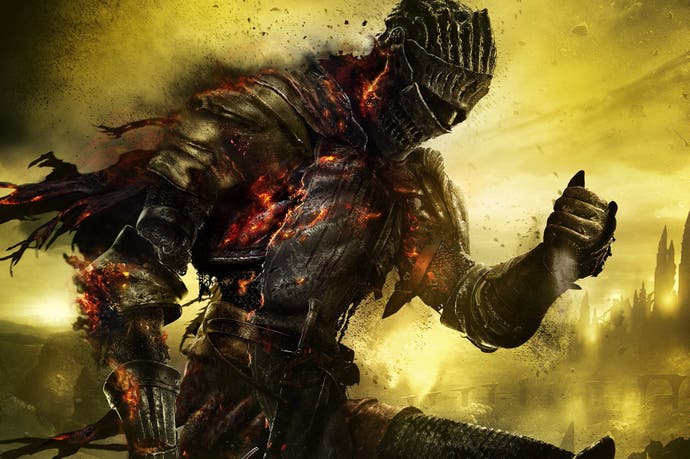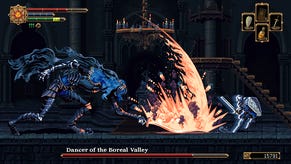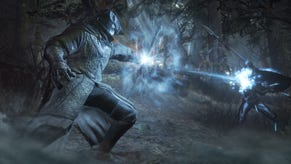Face-Off: Dark Souls 3
Clash of the consoles: PS4 takes on Xbox One.
Developed by two separate teams within From Software, Dark Souls 3 arrives a year on from the excellent Bloodborne, with the apparent aim of bringing closure to the Souls series. The engine of the PlayStation 4 exclusive returns too, now put to work in rendering a beautiful, withered fantasy world on other formats, including Xbox One and PC. Today we focus on the two console versions - a clash that reunites Sony's machine with From's core tech to bring out some clear PS4 advantages.
To start, this is the first Dark Souls title where resolution differs between two console competitors. The final PS4 code pushes a native 1920x1080 image - as was the expectation after its network beta - while Xbox One instead opts to upscale from a lower 1600x900 frame-buffer. Such a resolution drop on Microsoft's machine marks a running trend across this generation so far, and Dark Souls 3 joins a growing list of titles where PS4 offers an image quality lead. To back this, both consoles use a matching style of post-process anti-aliasing to deal with visual noise.
Despite this extra upscale, Xbox One still presents Lothric in a flattering light. In play, the one truly perceptible shortfall of its native 900p image is that pixel crawl flares up more aggressively across foliage - though otherwise its visuals hold up very well. Bizarrely, all HUD elements on Xbox One (such as menus and health bars) are also rendered at 900p. Rather than setting these 2D elements to display at 1080p over gameplay - a tactic used in most sub-native titles - they're instead put through the same scaling process. As a result we get a light blur to item illustrations, one that shows up next to PS4's, and it's a shame given there is a commonly practiced workaround here.
In terms of the core visual makeup, both PS4 and Xbox One impress from the off with the gorgeous Cemetery of Ash area - a flooded ruin built to a mountainside. Embers glow from between armour cracks, and though aspects of this initial area appear a touch plain (notably in plots of grass strewn across the terrain) the craft behind each new environment shows its focused three years of development. From Software's blend of horror and high fantasy pays off in Dark Souls 3, and more so than any of its intervening works, it strikes an aesthetic that comes the closest we've seen to that of the very first Dark Souls.
It's a great looking game, but does either console miss out on any key features? All visual settings are identical between PS4 and Xbox One, sparing one obvious difference in shadow resolution. Xbox One uses a lower quality setting for shadow rendering, giving character silhouettes an aliased, rougher look. Against bright backdrops, it sticks out next to the PS4's smoother shadow outlines. Besides the drop to 900p, this forms the only readily apparent downgrade on Xbox One, where textures, effects, reflection mapping, draw distances and even impact ripples on water are a match between the two.
Screen-space ambient occlusion is engaged on both, while lighting effects such as god rays return from their atmospheric use in Bloodborne. It's even improved in certain aspects over the PS4 network beta we played last year. Indeed, motion blur is added to the final product, with hard camera pans now cueing a full-screen form of the effect. On freezing the frame mid-motion, Xbox One shows a slightly rougher delivery of the effect - a dithered look that arises from samples being taken from a 1600x900 image. It's not a major issue at gentler velocities, but it bears mention when compared to the PS4's implementation of the effect at its extremes.
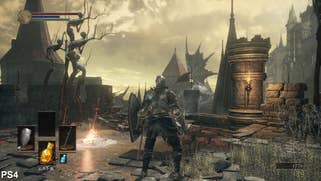
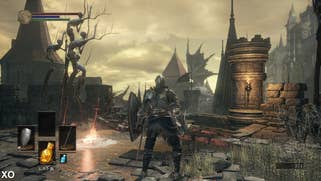
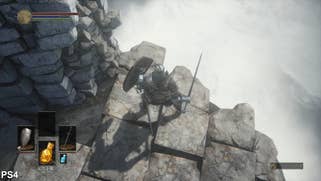

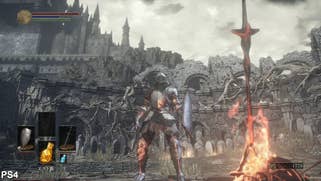
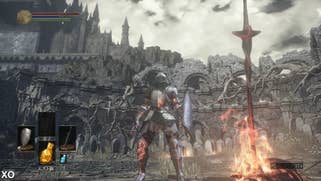
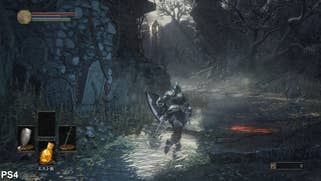
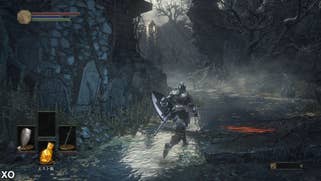
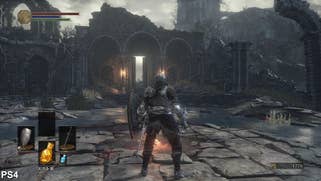
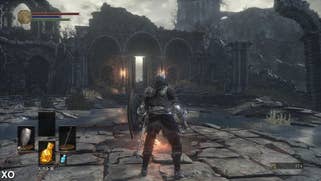
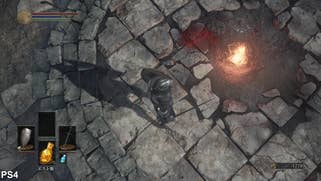

Visually it's a clear-cut case in favour of PS4, and we'd have hoped Xbox One's graphical sacrifices might translate to a matching level of performance. As we've already seen in isolation, Xbox One is capped at 30fps with v-sync, but has dips to the mid-20s around volumetric fog effects of its opening scene, and also bosses making use of From Software's shader effects. The results aren't always smooth, but for the majority of play (at least from what we've tested to date) the game holds at 30fps.
However, PS4 offers a performance advantage too. Almost every area prone to a 25fps drop on Xbox One instead runs at the intended 30fps on PS4. The stress-point which catches Sony's machine off-guard is on the approach to the Firelink shrine, the complexity of which forces a dip to 28fps (while Xbox One falls even lower). It translates to a broadly smoother experience on PS4, though the frustrating reality is that both consoles suffer from frame-pacing issues. As with Bloodborne, neither PS4 or Xbox One versions of Dark Souls 3 feel as smooth as they should do, even while running at the target 30fps on average. Frames are incorrectly ordered to produce a stuttering sensation, and our hopes of From Software addressing the issue are once again dashed.
In such a sprawling game, we can't rule out another Blight Town situation popping up down the line - an area infamous for its 10fps drops on last-gen. However, the prospects after five hours of playing Dark Souls 3 are very positive, and we'll be sure to update this piece if anything particularly egregious crops up. As a comparison point between PS4 and Xbox One though, the division is clear, and sets a precedent for how frame-rates in rest of the game will bear out.
Dark Souls 3 on console - the Digital Foundry verdict
PS4 is the preferred pick for several reasons. From Software makes a number of visual concessions on Xbox One, dropping its native resolution to 900p, and also edging down shadow and motion blur quality. None of these cuts dampen the quality of the experience to any radical degree, and it's perfectly enjoyable on Xbox One as-is. However, it's undeniable PS4 brings out the best in From Software's latest project, presenting its world at a clearer 1080p, and with a firmer grasp on its 30fps target to boot.
At a technical level it's intriguing to see the studio's engine return in Dark Souls 3. This time it stretches beyond the moody, gothic designs of Bloodborne to deliver a more vibrant, varied suite of areas, and we can't wait to see what other locales the game has lined up. Putting its recurring frame-pacing issue aside, the technology realises some of the most striking fantasy concepts we've seen on PS4 and Xbox One. But looking to the impending PC release, seeing the engine potentially run at a flawless locked 60fps for once is very exciting prospect indeed.
We'll be back with PC coverage on this as soon as possible, and with a close dissection of what its presets add (or perhaps not) over the console release. Dark Souls 3's worldwide release looms on April 12th, and for those happy to hold off on the Japanese version, it's well worth the wait. Just be sure to go in with a raised shield when the time comes.
